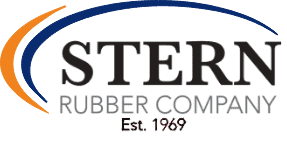Stern Rubber Attends International Elastomer Conference
Bob Jackson (President), and Connie Krueger (Purchasing Supervisor) attended the International Elastomer Conference, held in Cleveland, OH, during the week of of October 12th. This conference was well covered by the Rubber & Plastics News, which recently featured an article about Stern Rubber Company.
Bob and Connie spent their time meeting with current and prospective material suppliers, and examining the many pieces of production and testing equipment that were set up and running. Some of the equipment included injection presses from Desma, Maplan, Rep, Engel, and others. There was also testing equipment from Alpha Technologies, MonTech, and TA Instruments, among others.
The most impressive thing that they found at the show was a mold that Desma was running in their injection press that was using new technology for the rubber industry. This was impressive, as it was a 4 cavity mold, but the 4 cavities were parts of different sizes. This is important, as usually for a part to run well in injection, the parts need to be identical, and the volume of the feed needs to be very evenly balanced. Desma had gotten around this by installing pressure sensors in each of the cavities. The cavities were each directly fed with a gate valve from a cold runner system. The gate valve was controlled by pressure sensors in the cavity, that were tied into the program of the press. As the smallest cavity reached the full point, the cavity pressure started to rise, and the press shut off the feed valve to that cavity. The other cavities continued to fill, and each of them shut off, as they got full, and the pressure started to rise. This was an expensive mold, as it required a cold runner, as well as the pressure sensors, and the press has to be outfitted with a specific control system. But, normally, if 4 different sized parts needed to be run, it would require 4 molds, instead of just one. There was also significant material and secondary labor savings, as this system allowed these parts to be run flash free, and there was no waste from a runner system. This system has additional possible positive ramifications as well. By monitoring the cavity pressure as the parts cure, this could also be used to monitor the cure state, to minimize the cure time, for additional time and cost savings.
Another place where this technology could be helpful, would be for making rubber to metal bonded parts, where a casting is used. Castings (especially sand cast parts) have a lot of variation
in size and volume. This is important, as normally when molding this type of part, you need to use extra material for all of the cavities, to make sure that there is enough material to take up the extra room left by the smallest castings. This means wasting extra material, and having to take the time to remove all the extra flash. By using a cold runner with the pressure monitoring system, it could be run to always use the exact correct amount of material, and to minimize the flash that hasto be removed.
It was wonderful to see the new technology, and from the number of exhibitors and attendees, it appears that the rubber industry is healthy!
To see videos that were filmed at the conference, please click here.
